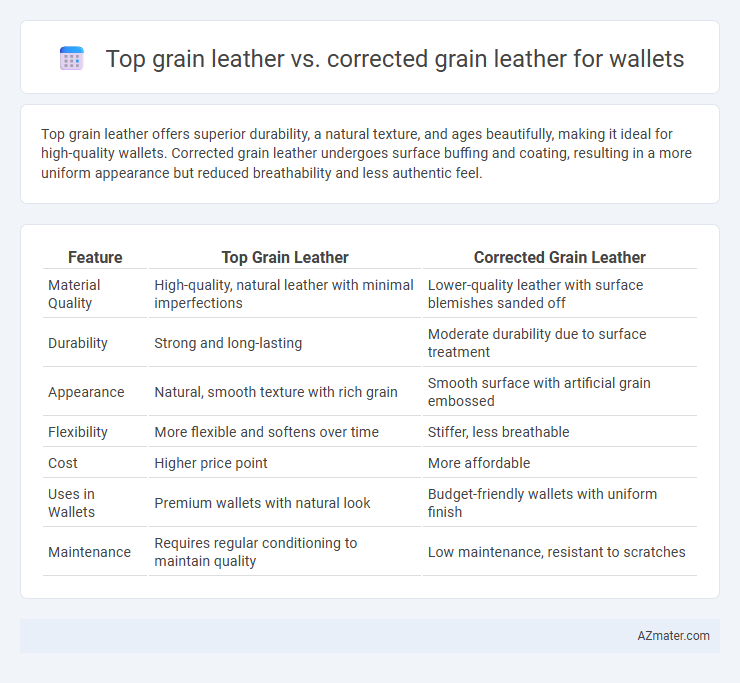Top grain leather offers superior durability, a natural texture, and ages beautifully, making it ideal for high-quality wallets. Corrected grain leather undergoes surface buffing and coating, resulting in a more uniform appearance but reduced breathability and less authentic feel.
Table of Comparison
| Feature | Top Grain Leather | Corrected Grain Leather |
|---|---|---|
| Material Quality | High-quality, natural leather with minimal imperfections | Lower-quality leather with surface blemishes sanded off |
| Durability | Strong and long-lasting | Moderate durability due to surface treatment |
| Appearance | Natural, smooth texture with rich grain | Smooth surface with artificial grain embossed |
| Flexibility | More flexible and softens over time | Stiffer, less breathable |
| Cost | Higher price point | More affordable |
| Uses in Wallets | Premium wallets with natural look | Budget-friendly wallets with uniform finish |
| Maintenance | Requires regular conditioning to maintain quality | Low maintenance, resistant to scratches |
Introduction to Leather Types
Top grain leather, sourced from the upper layer of the hide, offers superior durability and natural grain patterns, making it a premium choice for wallets with a smooth, refined finish. Corrected grain leather undergoes buffing and stamping to remove imperfections, resulting in a more uniform appearance but slightly less breathability and character compared to top grain. Selecting between these leather types impacts the wallet's texture, longevity, and aesthetic appeal based on the quality and treatment of the hide.
What is Top Grain Leather?
Top grain leather is the second highest quality leather made from the top layer of the hide after the most outer layer is removed to eliminate imperfections, resulting in a smooth, durable surface with natural texture. It is prized for its strength, flexibility, and ability to develop a rich patina over time, making it an excellent choice for premium wallets. This type of leather retains much of the hide's original grain, providing a balance between aesthetics and longevity compared to corrected grain leather, which undergoes more extensive processing.
What is Corrected Grain Leather?
Corrected grain leather is leather that has been sanded and buffed to remove imperfections, then coated with a synthetic finish to create a uniform appearance. It is often used in wallets for its durability and consistent texture, though it lacks the natural markings and breathability of top grain leather. This type of leather is typically more affordable and resistant to stains, making it a practical choice for everyday use.
Key Differences Between Top Grain and Corrected Grain Leather
Top grain leather is made from the upper layer of the hide, offering natural durability, breathability, and a smooth, refined finish that develops a rich patina over time. Corrected grain leather, on the other hand, undergoes heavy sanding and buffing to remove imperfections, resulting in a more uniform appearance but reduced breathability and natural texture. For wallets, top grain leather provides superior longevity and a more authentic look, while corrected grain leather offers a more affordable, consistent aesthetic with less character development.
Durability Comparison of Each Leather Type
Top grain leather offers superior durability for wallets due to its intact grain layer, which resists wear and develops a natural patina over time. Corrected grain leather undergoes sanding and embossing to mask imperfections, resulting in a thicker but less breathable surface that may wear faster and show cracks with prolonged use. Wallets made from top grain leather typically last longer and maintain their strength better under daily handling compared to corrected grain leather counterparts.
Appearance and Aesthetic Differences
Top grain leather wallets feature a natural, smooth finish with visible grain patterns, offering a rich, luxurious aesthetic that develops a unique patina over time. Corrected grain leather wallets undergo sanding and embossing to mask imperfections, resulting in a more uniform but less natural textured surface often lacking the distinct character of top grain. The appearance of top grain leather is generally more refined and visually appealing, while corrected grain leather offers consistency at the expense of some authenticity in texture and aging.
How Each Leather Ages Over Time
Top grain leather develops a rich patina and softens with use, enhancing the wallet's appearance and feel over time. Corrected grain leather, treated to cover imperfections, tends to wear more uniformly but may lose its finish and show cracks or peeling with extended use. Wallets made from top grain leather generally offer superior durability and a more attractive aging process compared to the more processed corrected grain leather.
Price and Value Considerations
Top grain leather wallets typically command higher prices due to the use of superior, natural leather with minimal surface alteration, offering enhanced durability and a premium feel. Corrected grain leather wallets are more affordable as they undergo extensive sanding and coating to mask imperfections, which can reduce breathability and natural texture. Consumers seeking long-term value often prefer top grain leather for its balance of price, appearance, and longevity in wallets.
Which Leather is Best for Wallets?
Top grain leather offers superior durability, natural texture, and develops a rich patina over time, making it the preferred choice for high-quality wallets. Corrected grain leather undergoes extensive sanding and embossing to mask imperfections, resulting in a more uniform appearance but less breathability and a less authentic feel. For wallets, top grain leather excels in longevity and aesthetic appeal, while corrected grain leather suits budget-friendly options with consistent finishes.
Final Verdict: Choosing the Right Leather for Your Wallet
Top grain leather offers superior durability, natural texture, and a premium feel, making it ideal for long-lasting wallets that age beautifully. Corrected grain leather undergoes heavy surface treatment to mask imperfections, resulting in a more uniform appearance but less breathability and natural character. For wallets, top grain leather is the preferred choice for quality and longevity, while corrected grain suits budget-friendly options with consistent aesthetics.

Infographic: Top grain leather vs Corrected grain leather for Wallet
 azmater.com
azmater.com